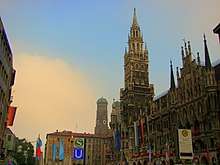Marienplatz
Marienplatz (en: Mary's Square, i.e. St. Mary, Our Lady's Square) is a central square in the city centre of Munich, Germany. It has been the city's main square since 1158.


Architecture
Marienplatz was named after the Mariensäule, a Marian column erected in its centre in 1638 to celebrate the end of Swedish occupation. Today the Marienplatz is dominated by the New City Hall (Neues Rathaus) on the north side, and the Old City Hall (Altes Rathaus, a reconstructed gothic council hall with a ballroom and tower) on the east side.
In the Middle Ages, markets and tournaments were held in this city square. It used to be called Markth (market), Schranne (grain market) and later Schrannenplatz (grain market square). After said grain market was moved into the modern glass-and-iron Schranne near "Blumenstrasse" in 1853, the square received its new name, starting 9. October 1854. The Glockenspiel in the tower of the new city hall was inspired by these tournaments, and draws millions of tourists a year. Furthermore, the pedestrian zone between Karlsplatz and Marienplatz is a crowded area with numerous shops and restaurants.
Mary's Column

.jpg)
The Mariensäule is a Marian column located on the Marienplatz in Munich, Germany. Mary is revered here as Patrona Bavariae (Latin: Protector of Bavaria). It was erected in 1638 to celebrate the end of Swedish occupation during the Thirty Years' War, to be precise, following a respective vow by Duke Elector Maximilian I of Bavaria if the ducal residential cities of Munich and Landshut would be spared from war destruction. The column is topped by a golden statue of the Virgin Mary standing on a crescent moon as the Queen of Heaven, created in 1590. The figure was originally located in the Frauenkirche. Mariensäule in Munich was the first column of this type built north of the Alps and inspired erecting other Marian columns in this part of Europe.[1]
At each corner of the column's pedestal is a statue of a putto, created by Ferdinand Murmann. The four putti are each depicted fighting a different beast, symbolizing the city's overcoming of adversities: war represented by the lion, pestilence by the cockatrice, hunger or famine by the dragon and heresy by the serpent.
The full inscription is as follows (with a translation below it)
DEO OPTIMO MAXIMO VIRGINI DEIPARAE BOICAE DOMINAE BENIGNISSIMAE PROTECTRICI POTENTISSIMAE OB PATRIAM VRBES EXERCITVS SEIPSVM DOMVM ET SPES SVAS SERVATAS HOC PERENNE AD POSTEROS MONVMENTVM MAXIMILIANVS COM. PAL. RHENI VTRIVSQVE BAVARIAE DVX S.R.I. ARCHIDAP. ET ELECTOR AND ELECTOR CLIENTVM INFIMVS GRATVS SVPPLEX POSUIT A. MDCXXXIIX
TO GOD THE BEST AND GREATEST THE VIRGIN, THE MOTHER OF GOD MISTRESS OF BAVARIA MOST BENIGN PROTECTRESS MOST POWERFUL; BECAUSE THE HOMELAND CITIES, ARMIES HIS OWN HOUSE AND HIS HOPES WERE SAVED THIS LASTING MEMORIAL FOR THOSE TO COME MAXIMILIANVS PALSGRAVE OF THE RHINE RULER OF BOTH BAVARIAS PRINCE OF THE HOLY ROMAN EMPIRE AND ELECTOR THE WORST OF HIS SERVANTS A GRATEFUL SUPPLICANT PUT UP IN THE YEAR 1638
Christmas Market
Three weeks before Christmas the Christkindlmarkt opens at Marienplatz and other squares in the city, selling Christmas goods and food and drink.
Transport
The square is served by the Munich Marienplatz station, offering both U-Bahn and S-Bahn access.
A new station, Marienhof, will be built to the north of the square, as part of the second S-Bahn tunnel project (Zweite Stammstrecke). The new station will also connect to the existing lines. [2]
References
- For more and detailed pictures of the column see the respective German language article on wikipedia.de.
- "Contract awarded for new Munich rail station". World Construction Today. Retrieved 2019-01-28.
| Wikimedia Commons has media related to Marienplatz (Munich). |